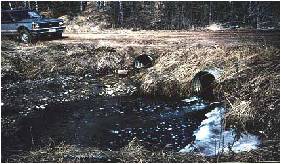| More About Water Pollution | |
|
The effects of water pollutants are generally similar regardless of the source, however point source pollution is often easier to control since individual companies can be identified and legislation and fines applied to industry for poor performance. Point source pollution comes from readily identifiable sources, such as a pipe draining from an industrial plant or sewage treatment facility. |

|
|
We can group water pollution into a number of broad categories,
Nutrients (organic matter), Toxins (metals, inorganics, organics),
Pathogens and Physical pollutants (thermal energy, sediments).
Nutrients for example, grass/garden waste, phosphorus and nitrogen can perhaps surprisingly have very damaging effects in lakes and other water courses particularly where flow is slow. These types of waste are biodegradable, that is, they can be broken down and used as food by microorganisms like bacteria. We tend to think of biodegradable wastes as being preferable to non-biodegradable ones, because they will be broken down and not remain in the environment for very long. However, too much biodegradable material can cause the serious problem of oxygen depletion in receiving waters. Aerobic bacteria that live in water use oxygen gas, which is dissolved in the water when they consume their "food". But, oxygen is not very soluble in water. Even when the water is saturated with dissolved oxygen, it contains only about 1/25 the concentration that is present in air. So if there is too much "food" in the water, the bacteria that are consuming it can easily use up all of the dissolved oxygen, this leaves no oxygen for other aquatic creatures like fish, that then die in effect by suffocation. Once the oxygen is gone, other bacteria that do not need dissolved oxygen take over. Unfortunately whilst aerobic microorganisms, (those which use dissolved oxygen), convert the nitrogen, sulfur, and carbon compounds that are present in the wastewater into odorless and relatively harmless forms, anaerobic microorganisms produce toxic and smelly ammonia, amines, and sulfides, and flammable methane (swamp gas). Phosphorus and nitrogen are the main components in fertilisers. Added to lakes and streams, they cause nuisance growth of aquatic weeds, as well as "blooms" of algae, which are microscopic plants. This can also lead to the same problems since eventually the algae and weeds die and become biodegradable material. This process of change is known as Eutrophication. Physical pollutants Particulate matter, consist of small particles which are suspended in the water, (suspended solids). A test for this is often applied to waste water from industry when local discharge consents are set. Although they may be kept in suspension by turbulence, once in the receiving water, they will eventually settle out and form silt or mud. These sediments can decrease the depth of the body of water. If there is a lot of biodegradable organic material in the sediment, it will become anaerobic and contribute to problems caused by nutrients. Toxic materials can also accumulate in the sediment and affect the organisms, which live there. Some toxins build up in the food chain until the fish and larger wildlife predators contain high concentrations of pollutants this process is known as Bio-magnification and can have devastating effects on local human populations that rely on the watercourse for food. Greasy/oily particulate matter is also of concern since it can coat the surface with a layer, which inhibits the oxygen exchange leading to the death of the inhabitants of the water. Suspended solids can also prevent sunlight from reaching aquatic plants, clog fish gills, choke other organisms, and can smother fish spawning and nursery areas. Thermal Pollution In a modern generating plant, 40% of the coal's energy is converted to electric energy, while the remaining 60% becomes waste heat. Some of this heat goes up the chimney, but the rest must be removed to keep the generators working. Cold water sucked from rivers, lakes or ocean has traditionally been used to absorb this waste heat. A large plant requires so much water, as much as 500,000 gallons per minute, that it may use a good fraction of the entire flow of a small river. The warm discharge water causes thermal pollution by raising the temperature of the river. Many organisms, particularly cold-blooded ones, are especially vulnerable to changes in temperature. Moreover, as water temperature rises, the water holds less oxygen, so organisms may die from oxygen starvation if not from the heat itself. Heat-loving organisms cannot become established because the output of hot water varies, decreasing to nothing when the plant shuts down. Besides the problem of thermal pollution, there are also the harmful effects on fish and other creatures that are sucked through the plant's cooling system. The sudden temperature rise, action of the pumps or chlorine added to prevent clogging growths of microorganisms can all be lethal. Screens are added to filter out the larger fish, but small organisms are still trapped and killed. Table 2 on the next page indicates pollutants, their major sources and some of the general effects. |
|